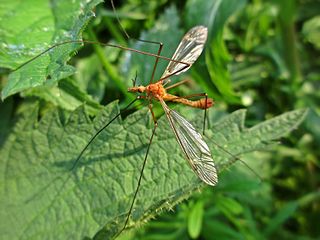
A crane fly is any member of the dipteran superfamily Tipuloidea, which contains the living families Cylindrotomidae, Limoniidae, Pediciidae and Tipulidae, as well as several extinct families. "Winter crane flies", members of the family Trichoceridae, are sufficiently different from the typical crane flies of Tipuloidea to be excluded from the superfamily Tipuloidea, and are placed as their sister group within Tipulomorpha.

Limoniidae is the largest of four crane fly families, with more than 10,700 species in more than 150 genera. Some studies have suggested it to be a paraphyletic group, with some limoniids being more closely related to Tipulidae and Cylindrotomidae than to other limoniids. Limoniid crane flies can usually be distinguished by the way the wings are held at rest. Limoniids usually hold/fold the wings along the back of the body, whereas other crane flies usually hold them out at right angles. Snow flies such as Chionea scita have no wings at all. Limoniids are also usually smaller than other crane flies, with some exceptions.

The Sciaridae are a family of flies, commonly known as dark-winged fungus gnats. Commonly found in moist environments, they are known to be a pest of mushroom farms and are commonly found in household plant pots. This is one of the least studied of the large Diptera families, probably due to the small size of these insects and the similarity among species.

Caenorhabditis is a genus of nematodes which live in bacteria-rich environments like compost piles, decaying dead animals and rotting fruit. The name comes from Greek: caeno- ; rhabditis = rod-like.
Caenorhabditis brenneri is a small nematode, closely related to the model organism Caenorhabditis elegans. Its genome is being sequenced by Washington University in St. Louis Genome Sequencing Center. This species has previously been referred to as C. sp 4 and Caenorhabditis sp. CB5161, but was recently formally described and given its scientific name. This name is in honor of Sydney Brenner, recognizing his pioneering role in starting active research in the field of C. elegans biology and development.

Tipula paludosa is a species of true craneflies, family Tipulidae. It is also known as the European crane fly or the marsh crane fly. It is a pest in grasslands of Northwest Europe and has been accidentally introduced to North America.

Tipula lunata is a species of cranefly which is widespread throughout the Palaearctic.

The Cylindrotomidae or long-bodied craneflies are a family of crane flies. More than 65 extant species in 9 genera occur worldwide. There are more than 20 extinct species.

Tipula nubeculosa is a species of cranefly. It is widespread throughout the Palaearctic, including Belgium where it can be found living in damp forest habitats. Tipula nubeculosa can reach lengths of 17-30 mm, with a wingspan of 18-23 mm. T. nubeculosa is a host species for the parasitic larvae of Admontia grandicornis.

Caenorhabditis angaria is a small nematode, in the same genus as the model organism Caenorhabditis elegans. The name is from the Latin after the tendency to ride weevils. Prior to 2011, the species was referred to as C. sp. 2, C. sp. 3, and C. sp. PS1010. Its genome was sequenced at the California Institute of Technology in 2010. This species is gonochoristic. It has distinct morphology and behavior compared to C. elegans; notably, C. angaria males exhibit a spiral mating behavior. Its divergence from C. elegans is similar to the distance between humans and fish. C. castelli is its closest relative, and the two species can produce F1 hybrids.
Phasmarhabditis (Greek: Phasma = (φάσμα ; rhabditis = is a genus of bacterial-feeding nematodes which are facultative parasites whose primary hosts are terrestrial gastropods. The name comes from Greek: Phasma- (φάσμα ; rhabditis = rod-like (ῥάβδος. The genus is made up of 18 species including P. hermaphrodita, P. californica, P. neopapillosa, P. papillosa, P. apuliae, P. bohemica, P. bonaquaense, P. huizhouensis, P. nidrosiensis, P. valida and P. tawfiki.
Victor Marc Nigon was a biologist who was first to study the nematode worm Caenorhabditis elegans in the laboratory, with Ellsworth Dougherty, in the 1940s.
Ellsworth C. Dougherty was a biologist who was first to study the nematode worm Caenorhabditis elegans in the laboratory, with Victor Nigon, in the 1940s. He did most of his studies and medical work in California.

Caenorhabditis sinica, is a species of Caenorhabditis nematodes, belonging to the Elegans super-group and Elegans group within the genus. It is closely related to several species isolated from the lands adjacent to the Indian and Pacific Oceans, as well as to C. briggsae and C. nigoni. The species was known as “C. sp. 5” prior to 2014. C. sinica is known for having very high genetic diversity in its genome. Like other Caenorhabditis species, C. sinica is a ~1mm long roundworm with a transparent cuticle and that eats bacteria. Wild isolate strains of C. sinica have been collected from various rotting plant tissue substrates in temperate and tropical regions throughout China since its initial isolation in 2005.
Oscheius is a genus of nematode.
Mesorhabditis is a genus of nematodes.
Protorhabditis is a genus of nematodes in the family Rhabditidae.
"Crocebacterium ilecola" is a Gram-positive, non-spore-forming and motile species of bacteria from the family of Microbacteriaceae. "Crocebacterium ilecola" has been isolated from the hindgut of the larva Tipula abdominalis from United States.









